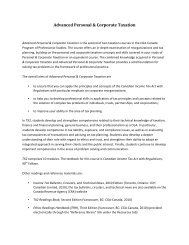Financial Accounting: Liabilities & Equities (FA3) Exam Review
Financial Accounting: Liabilities & Equities (FA3) Exam Review
Financial Accounting: Liabilities & Equities (FA3) Exam Review
Create successful ePaper yourself
Turn your PDF publications into a flip-book with our unique Google optimized e-Paper software.
<strong>FA3</strong> <strong>Exam</strong> <strong>Review</strong> notes Barbara Wyntjes, CGA, MBA, B.Sc.<br />
Part 3: Module 3 – Shareholders’ Equity<br />
Blueprint: 9-12%<br />
a. JMN Company had opening retained earnings of $100,000. Net income for the year<br />
was $23,000. During the current year, an error in the prior year was discovered resulting<br />
in a credit to retained earnings for $5,000, and 1,000 shares were retired at $2 above their<br />
book value. There was no contributed capital account prior to the retirement of the shares.<br />
Ending retained earnings was $102,000. What was the amount of dividend declared for<br />
the year?<br />
1) $14,000<br />
2) $24,000<br />
3) $26,000<br />
4) $28,000<br />
b. When a property dividend is declared, the book value of the property and the market<br />
value are not the same. How should the dividend be recorded?<br />
1) It should be recorded at the book value of the property at the date of declaration.<br />
2) It should be recorded at the market value of the property at the date of declaration.<br />
3) It should be recorded at the market value of the property at the date of distribution.<br />
4) It should be recorded at the book value or market value, whichever is higher at the date<br />
of declaration.<br />
c. What is a dividend called when a portion of the shareholders’ original investment is<br />
returned?<br />
1) Equity dividend<br />
2) Special dividend<br />
3) Liquidating dividend<br />
4) Compensating dividend<br />
d. Which of the following type of dividends does not reduce retained earnings?<br />
1) Cash dividend<br />
2) Stock dividend<br />
3) Property dividend<br />
4) Liquidating dividend<br />
e. DKM Co. previously issued cumulative non-convertible preferred shares with an<br />
annual dividend payable on December 31. Dividends were last paid on December 31,<br />
2002, and no dividends were declared in 2005. In DKM’s December 31, 2005 financial<br />
statements, how will DKM report these dividends in arrears?<br />
1) Subtract 3 years of dividends on preferred shares from earnings when computing 2005<br />
basic earnings per share<br />
2) Report a liability equal to 2 years of dividends on the preferred shares<br />
3) Disclose in a footnote that the dividends on preferred shares are 2 years in arrears<br />
4) Disclose in a footnote that the dividends on preferred shares are 3 years in arrears<br />
8






